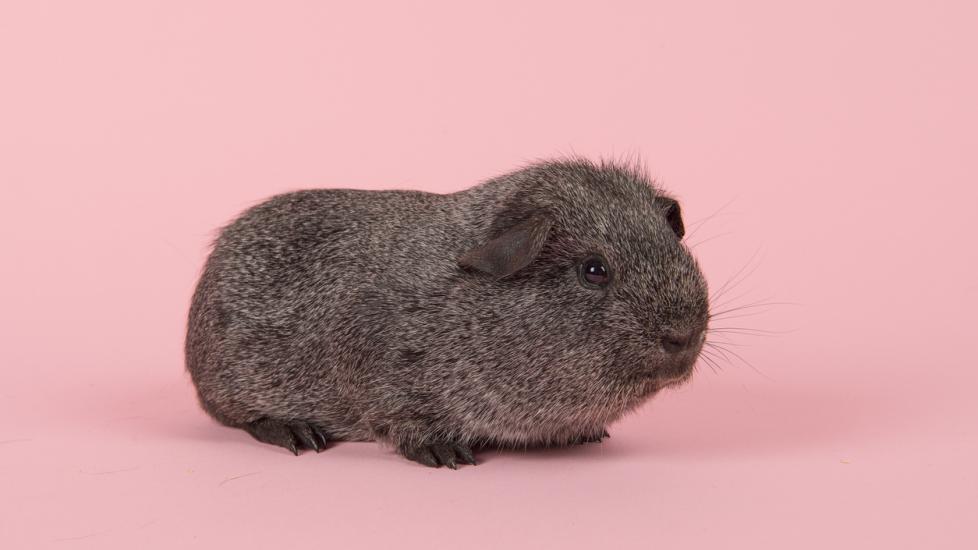Ringworm in Guinea Pigs
What Is Ringworm in Guinea Pigs?
Ringworm is a fungal infection that affects the fur, skin, and nails of a guinea pig. The fungus, known as dermatophytosis, invades the top layer of a guinea pig’s skin. Although ringworm is uncommon in guinea pigs, infections tend to occur in young, much older, pregnant, or otherwise immunocompromised animals. Ringworm can also occur in guinea pigs if they are stressed, in overcrowded environments, or in unsanitary environments.
Symptoms of Ringworm in Guinea Pigs
Signs of ringworm infection in guinea pigs include:
-
Irregular patches of fur loss
-
Crusts at the edges of lesions
-
Redness or inflammation on the face, feet, and trunk/dorsum
-
Patches can be itchy or not itchy depending on secondary infections
-
Roughened hair coat
-
Nail bed infections can occur but are rare in guinea pigs
Causes of Ringworm in Guinea Pigs
In guinea pigs, the Trichophyton mentagrophyte organism is the most likely cause of ringworm. This organism is present in the soil and can be carried by animals or humans. The organism is zoonotic, which means it can be spread from animals to humans (and vice versa) through direct contact or contact with a contaminated environment. If you notice lesions on you or your family members, please consult your primary care physician.
Other less common organisms that may cause ringworm in guinea pigs include Trichophyton behamiae and Microsporum canis.
How Veterinarians Diagnose Ringworm in Guinea Pigs
Your veterinarian will likely start with a cytology study, or cell analysis, of the hair. This usually means plucking hairs and looking at them under the microscope to look for bacteria, yeast, self-inflicted barbering, mites/lice, other parasites, and the fungus/dermatophyte spores in and on the hair shaft.
A woods light lamp (fluorescent lamp) is often used to look for Microsporum on cats and dogs. During this examination, your veterinarian looks for a green glow at the base of the hair shaft. This test is seldom diagnostic in guinea pigs because Microsporum is often not the cause of ringworm, but it is good to rule it out.
To confirm ringworm, a fungal culture must be performed. First, your veterinarian will pluck hairs around the skin lesions and place them on a culture plate. The sample will then be left for at least 10-21 days to see if the fungus grows.
Your veterinarian may also perform a new type of test called a rapid dermatophyte PCR (polymerase chain reaction). The PCR test which analyzes the hairs to look for fungal DNA. These results come back in 3-5 days.
Biopsy of the skin and testing for fungal infection could also be performed but this is often not necessary.
Treatment of Ringworm in Guinea Pigs
Your veterinarian might prescribe oral antifungals such as itraconazole/terbinafine, topical antifungal shampoos/sprays like miconazole/chlorhexidine, or clotrimazole lime sulfur dips. Treatment may last be for 1-6 weeks, depending on which therapy is chosen.
Topical therapy directly kills the fungal spores. Oral antifungals help stop the fungus from reproducing but are often only used if the infection is widespread and severe because there can be adverse side effects.
Recovery and Management of Ringworm in Guinea Pigs
Ringworm can lead to secondary bacterial infections that cause ulcers, itchiness, and self-trauma, so it's essential to seek veterinary attention if you see any signs of infection.
It is also essential to improve sanitary conditions in the environment. Frequently mop hard surfaces and disinfect the cage once a week during treatment to prevent reinfection once treatment has stopped.
Your veterinarian might want to perform fungal cultures during and after treatment to assess progress.
Prevention of Ringworm in Guinea Pigs
It is imperative to treat your guinea pig’s environment to prevent reinfection. You can disinfect the cage with sodium hypochlorite (1:10 dilution), benzalkonium chloride, 0.2% enilconazole solution, glutaraldehyde, or a 1:10 bleach solution. Leave the solution in contact with the cage for 10 minutes. Rinse all surfaces thoroughly afterward, and consult with your veterinarian about which option is best for you and your family.
It is essential to throw away any objects in the cage that cannot be disinfected, like wood.
As always, give your guinea pig good quality hay, commercial pellets, vitamin C supplements, minimize stress, and quarantine all new incoming animals for 30 days before introducing and allowing contact.
Ringworm in Guinea Pigs FAQs
Can ringworm kill guinea pigs?
Ringworm is typically not fatal unless your guinea pig has a severe underlying medical condition.
Can humans get ringworm from guinea pigs?
Humans can get ringworm from guinea pigs, so it is vital to wash your hands after handling or wear gloves during the treatment process. In addition, during treatment, keep any young, older, immunocompromised individuals away from the guinea pig.
References
Help us make PetMD better
Was this article helpful?
